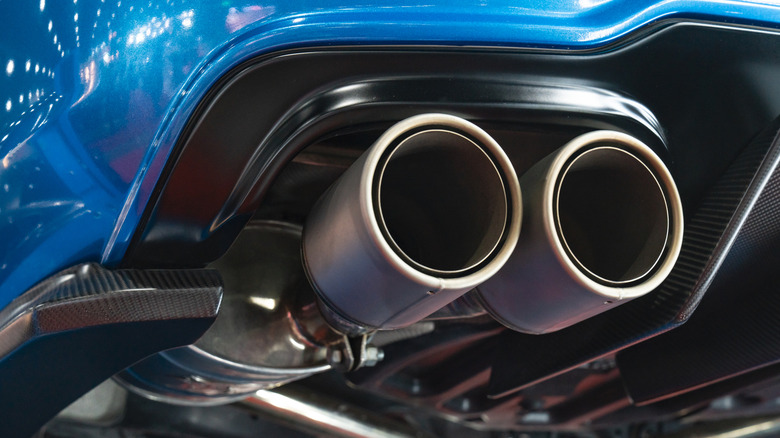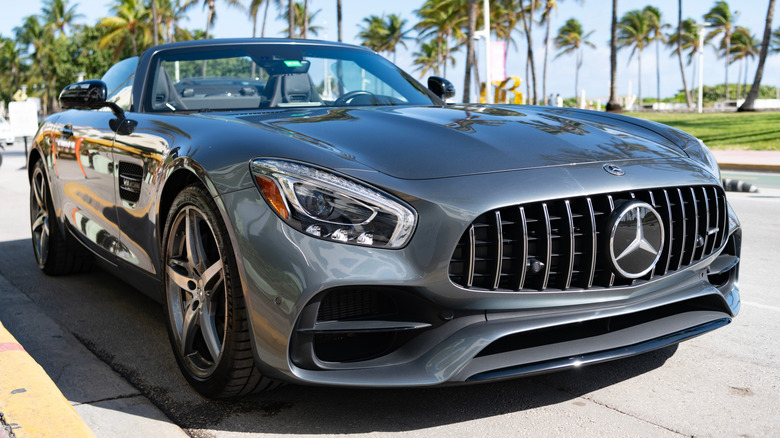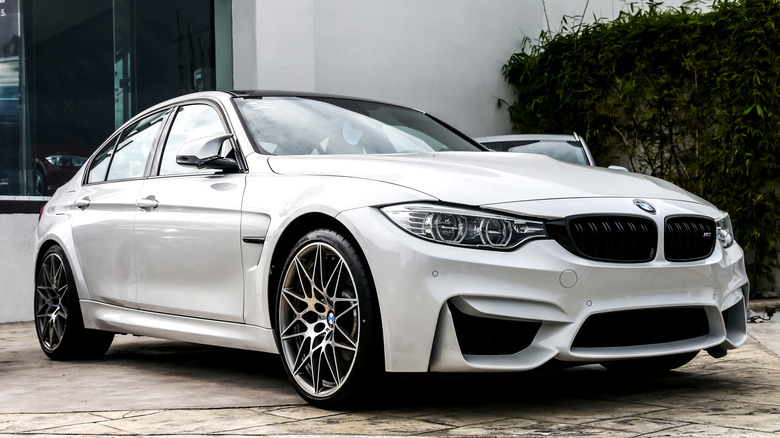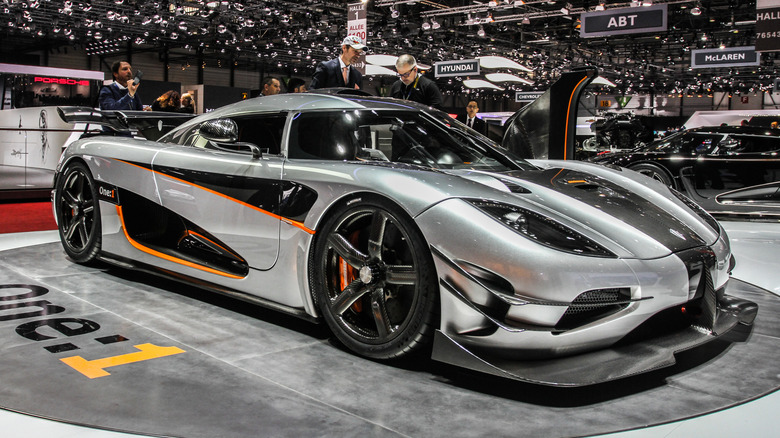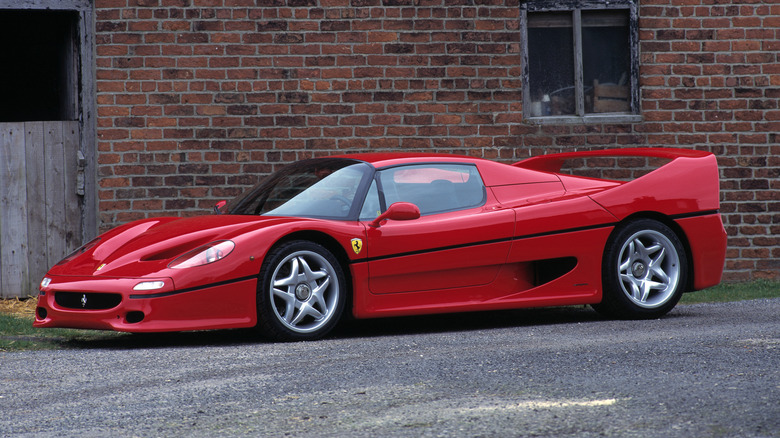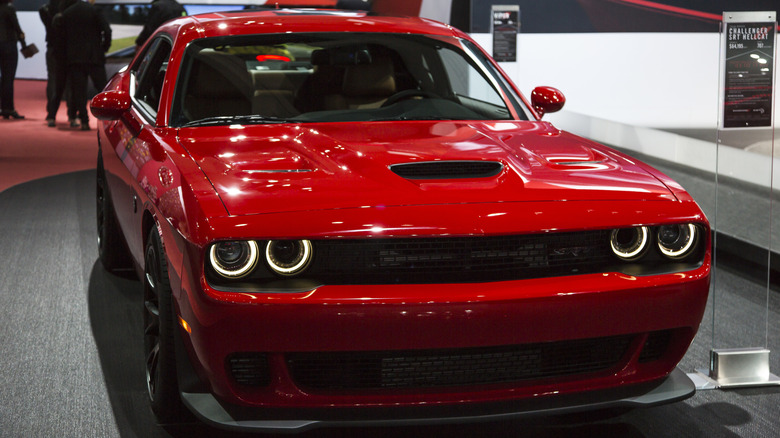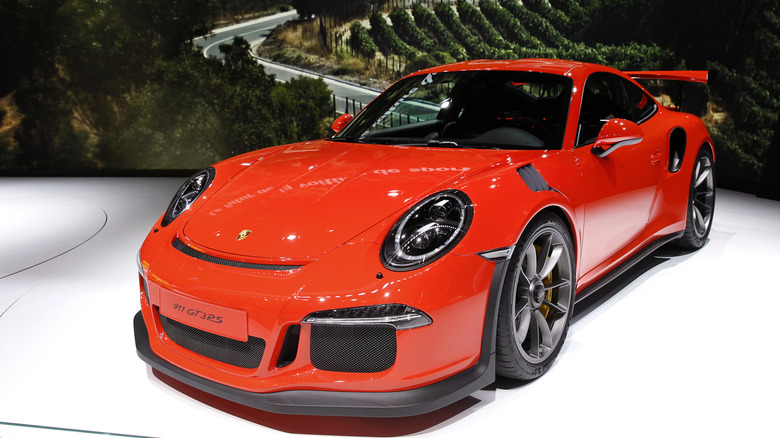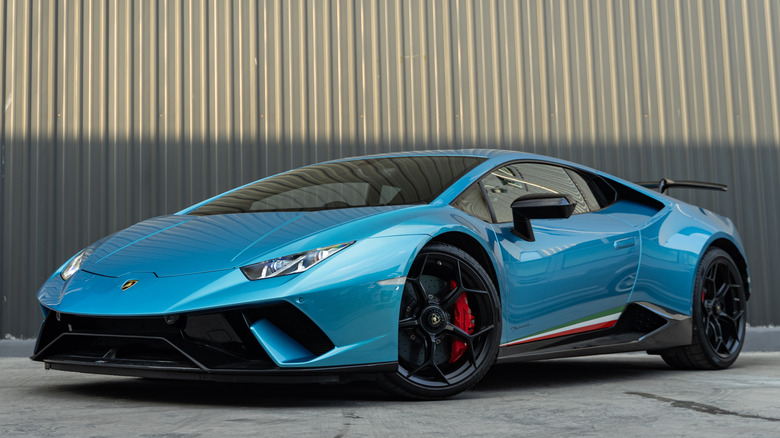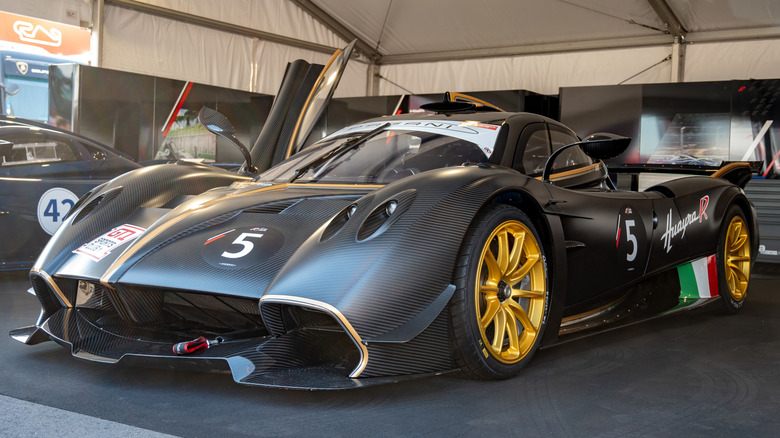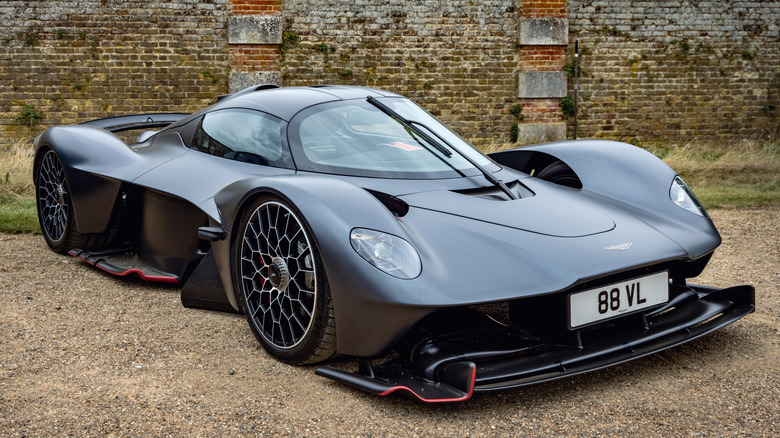10 Of The Loudest Cars Ever Made
Depending on what you're looking for in a car, noise can be a good thing, or a bad thing. Some of us want a quiet commuter that won't wake up the neighbors when we head off to work in the mornings. Some of us want the chipper sports car that'll give a little purr when we stab the throttle. And of course, some of us want the howling supercar that'll notify everyone within a couple city blocks of its presence before it reaches the redline. Most cars we see everyday belong to the first group, but the handful that belong to the last are worth mentioning.
To give some context in measurements, a 2019 Toyota Corolla, the epitome of a normal car, produces a cool 69 decibels at a smooth 70 mph. That's enough for most people, but if you have some extra cash and an affinity for mischief, there are some rowdier options out there. Here are 10 of the loudest cars ever made.
2021 Mercedes AMG GT Roadster (86 dB)
Muscle cars are some of the first vehicles that come to mind when you think of noise, and while the 2021 Mercedes AMG GT Roadster isn't part of the American muscle family, it's part of Germany's answer to it. The AMG GT, whether in roadster or coupe form, is Mercedes' premier two-door sports car that sits near the top of the brand's lineup. The AMG GT Roadster is a brutish German workhorse that relies on a 4.0-liter twin-turbo V8 to produce its guttural 86 decibel growl. The performance figures reflect AMG GT Roadster's sporty DNA as well, reaching 60 mph in 3.4 seconds and crushing the quarter mile in 11.5 seconds.
If the AMG badge isn't enough to warn you of this car's rowdiness, its design should be. To produce its 469 horsepower, the engine needs a hefty supply of air to keep it cool. To efficiently feed the engine cool air, the AMG GT Roadster breathes through a gaping Panamericana grille that gives the car an aggressive expression. The rear haunches are wide and muscular, and the cockpit sits behind a long hood that evokes memories of the wild SLS AMG. The key feature of the Roadster, though, is its lack of a roof, allowing drivers to hear all the ruckus.
2017 BMW M3 Competition (88 dB)
Compared to the AMG GT Roadster, the 2017 BMW M3 Competition adds two doors, and two decibels. It may be a sedan, but make no mistake: The M3 Competition is a serious car. BMW's Competition variants take the already powerful M cars and push their performance to the edge, often with a disruptive soundtrack. Powering the 2017 M3 Competition is a 3.0-liter turbocharged straight-six making 444 horsepower — 19 more horsepower than the regular M3. The engine revs to 7,000 RPM, and shoots the M3 Competition to 60 mph in four seconds flat.
Continuing on the theme of German muscle cars, the M3 Competition's looks are as aggressive as its sounds. The 2017 model is part of the F80 generation and wears the brand's signature angel eyes headlights along with wide fenders and 20-inch rims. To match the upgraded power numbers, the M3 Competition boasts a stiffer, more performance-oriented suspension that makes you forget you're going that fast in a four-door car. The exhaust note is angrier than the regular M3, and it roars to 88 decibels when you plant your foot to the floor.
2023 Porsche 718 Spyder RS (96 dB)
Many crown the 911 GT3 RS as Porsche's most hardcore model, but since 2023, the 718 Spyder RS has been fighting for its big brother's title. It's the first Porsche outside the 911 family to receive the coveted RS badge. Porsche's RS models, standing for RennSport ("racing sport") in German, get the company's full performance makeover. Everything is lighter, faster, and louder. The soul of the Spyder RS is in its high power output and low weight. The Spyder RS sheds sound-deadening materials, loses its metal badge for a sticker version, and most importantly, trades its metal roof for a canvas one. All this means the Spyder RS weighs only 3,214 pounds.
But lightness without power is nothing. Luckily, the Spyder RS isn't lacking in that department either. Its 4.0-liter flat-six engine produces 493 horsepower, which can shoot the Spyder RS to 60 mph in a cool 2.8 seconds. More importantly, though, the engine is a descendant of the 992 911 GT3's engine, and revs to 9,000 rpm. For those who want a car with theatrics to match its performance, this is the one. The lack of a roof, paired with this engine, lets drivers hear the Spyder RS's uncensored and unbound 96 decibel song.
2014 Koenigsegg One:1 (103 dB)
If you want something that breaks the 100 decibel mark and, and if you have a few spare millions laying around, the Koenigsegg One:1 might be the car for you. Christian Von Koenigsegg and his team of engineers seem to be from another planet, because every car they make seems to be at odds with reality. Even at the 2014 release of the Koenigsegg One:1, the story was the same. The Swedish brand revealed a car that nearly achieved a perfect ratio of one horsepower per kilogram, and a top speed of 273 mph, thanks to its monstrous 1,341 horsepower.
In 2015, after the One:1's release, Koenigsegg wanted to flex its muscles and set a new lap record for production cars at Spa-Francorchamps. Everything was set, and Koenigsegg was given an hour to do some hot laps. The car was performing exactly as expected, but its 5.0-liter twin turbo V8 revved all the way to its 8,250 rpm redline and broke the track's 103 decibel sound limit. The car was black flagged, and its hopes of a new lap record faded away. This beast of a car was simply too loud for its own good.
1995 Ferrari F50 (104 dB)
The oldest car on this list, the 1995 Ferrari F50, was ahead of its time in many ways, including its ability to produce a racket. The descendant of the legendary F40, the F50 was Ferrari's flagship supercar of the '90s, built following the design and engineering cues of Ferrari's successful Formula One team. It followed the Formula One DNA so closely that the F50 came without power steering or an ABS system, but what it did come with was a naturally aspirated V12 that achieved max power at 8,500 rpm.
The F50 made 512 horsepower and reached 62 mph in 3.8 seconds. The F50 was penned by the masters at Pininfarina to preserve Ferrari's elegant design language, while pairing it with aero elements to keep this weapon of a car stuck to the ground. All F50s were designed as targas as well, meaning owners could remove the roof panel for an open-top driving experience, and hear the F50's 104 decibel roar from the cockpit.
Dodge Challenger Hellcat (105 dB)
Though it may not be the loudest, the Dodge Challenger Hellcat does the best job of embodying the spirit of disruption and noise in every nut, bolt, and screw. While the Charger and the Durango have both gotten the Hellcat treatment, the Challenger wears it best as a classic two-door American muscle car. On the outside, the Challenger Hellcat looks angry. Four glowing eyes mark the edges of the front fascia, two of which have been hollowed out and serve as air intakes for the ever-hungry engine. The Hellcat looks like a base model Challenger on steroids. Everything is wider and longer, but the most drastic changes come from the engine bay.
The Hellcat's namesake is the Hellcat V8. This brash engine certainly believes bigger is better, with 6.2 liters of displacement and 707 angry American horses. The Hellcat V8 gets every horse at 6,000 rpm, but revs aren't the culprit of this car's signature soundtrack. The sound is low and snarling rather than a shrill shriek you might get from something with more cylinders and higher revs. The signature note for the Hellcat, though, is its supercharger. This twin-screw, 2.4-liter supercharger produces 11.6 pounds of boost and a demonic whine to go along with it. The low growl of the V8 paired with the high-pitched supercharger whine makes for a hellish, 105-decibel noise.
2016 Porsche 911 GT3 RS (108 dB)
Back to Germany for this entry, we return to the Porsche Spyder RS's big brother and the one who did it first. The 2016 Porsche 911 GT3 RS. The third generation of the GT3 RS line, the 2016 model knew how to make a racket about as well as it knew how to crush lap times on track. That's to say, it was an expert at both. Similar to the Spyder RS, the GT3 RS hit the gym and lost all its fat in creature comforts and luxury features. Depending on owner specifications, the GT3 RS can lose the air conditioning, sound system, front-axle-lift system, dashboard leather, and more. Almost all the body panels are made of lightweight materials like carbon fiber or magnesium, and to match the weight savings, power and aero have been upgraded as well.
The GT3 RS wears a tall rear wing, wider rear fenders to fit air intakes, and a front splitter. It loses some of the class of base model 911s, but what it lacks in grace, it makes up for in intensity. The engine, a flat-six of course, delivers 500 horsepower to the rear wheels, and hits 60 miles per hour in three seconds flat. That engine also revs to 8,800 rpm, and halfway through the rev range, the exhaust valves open fully to let the GT3 RS sing its 108-decibel battle cry.
2018 Lamborghini Huracán Performante (109 dB)
Like Ferrari, Lamborghini is all about drama, and a lot of times, drama brings noise. Where Ferrari may try to keep it reserved though, Lamborghini lets it all fly in cathartic intensity. Every Lamborghini has already been turned up to 11, but with the 2018 Lamborghini Hurucán Performante, they somehow push it even further. To improve performance, the Huracán Performante sheds 88 pounds compared to its civilian sibling thanks to the use of forged carbon and carbon fiber. Lamborghini's engineers blessed it with some clever active aerodynamics and carbon ceramic brakes. The engine, a 5.2-liter V10, produces a hefty 631 horsepower and screams all the way to 8,500 rpm. All this, and it's hard to believe that the Lamborghini Hurucán Performante doesn't want to kill you.
However, the Hurucán Performante still looks out for its poor mortal occupants in some ways. The car enjoys incredible cornering control thanks to its aero systems, and while it is rear-wheel biased in some of the sportier drive modes, the all-wheel-drive system can reign in the chaos when it becomes more frightening than exciting. No matter what drive mode you're in, though, the engine remains brazenly proud. The V10 makes a 109-decibel announcement of its presence with an operatic gusto that makes anyone in the car feel like they've tamed some kind of mythical beast.
2021 Pagani Huayra R (110 dB)
The 2021 Pagani Huayra R is similar to the Huracán Performante in that it's the track-ready and tuned-up version of one of Pagani's regular cars. A regular Pagani is a bit of an oxymoron, but the Huayra R's upgrades truly make the base Huayra look tame. The Huayra R is made of lightweight composite materials that sound like they were reverse-engineered from alien spacecraft. Carbo-Titanium HP62-G2 and Carbo-Triax HP62 make up the monocoque's body panels along with some carbon fiber here and there, and the result is a shape that balances form and function with ease.
To go along with its insane design, Pagani gave the Huayra R an insane engine as well. The Huayra R is powered by a 6.0-liter V12 that produces a massive 850 horsepower, which is delivered only to the rear wheels. The engine also revs to 9,000 rpm, and Pagani fitted it with an exhaust system that brings out every note. When fully unchained, the Pagani Huayra R can produce an astonishing 140 decibels. That's enough to damage your hearing instantly, which might be worth it given how good the Huayra R sounds. Normally, 140 decibels would put this car at the top of the list. However, the Huayra R is a track-only car, and most tracks follow the FIA limit of 110 decibels. In order to comply with these unfortunate rules, all Huayra R's come with a detachable exhaust muffling system that limits noise to the 110 decibel mark.
2021 Aston Martin Valkyrie (126 dB)
Finally, we reach the king of them all, the 2021 Aston Martin Valkyrie. There've been quite a few track cars on this list, but none of them quite reach the Valkyrie's pedigree. The car took five years to develop, with the first customer cars only being completed in 2021. Its engine comes from Cosworth, and its design comes from Adrian Newey. The result is not a road car decorated with Formula One technology, but a Formula One car with just enough regulations boxes checked that it meets road-going standards. The body is sculpted by air, and from the profile view, it looks like a teardrop falling horizontally. The weight saving is taken to an almost psychotic extent. The Aston Martin badge is only 40 microns thick, thinner than a human hair, and the brake lights are two tiny bulbs about the quarter of the size of the human eye.
Its powerplant is a 6.5-liter V12, which is supplemented by a small electric motor. The result is 1,139 horsepower and an astonishing 11,000 rpm redline. This car has no attachable mufflers like the Huayra R, which lets the Valkyrie shriek and wail its way all the way to 126 decibels. Because of the lack of sound deadening in the cabin, the Valkyrie comes with a set of headphones to protect occupants from the relentless noise and to be able to speak over the onboard intercom, helicopter style. That feature and that engine go to show that when it comes to noise, the Valkyrie has no competition.
